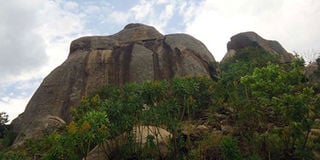Chinato rocks: Where lasting love is brewed

The crying stones of Chinato in Kuria East, Migori County. PHOTO | FILE | NATION MEDIA GROUP
What you need to know:
- During the early colonial days and in times of conflict, locals took refuge in the caves within the rocks.
- The boulders provide a vantage point for climbers to relax at the top as they marvel the picturesque view of the region.
The crying stones of Chinato in Kuria East, Migori County, stand tall and can be spotted from the Migori-Isebania road.
They characterise the beautiful environment of Kuria and have been protected by locals for ages.
They are a splendid geographical feature. One can get on top for a view of the Great Rift Valley.
Mr John Ng’ariba, an elder, says the rocks have a cultural significance.
During the early colonial days and in times of conflict, locals — especially women, the elderly and children — took refuge in the caves within the rocks.
“The Germans who colonised Tanganyika would cross the boundary and raid us. The vulnerable in our society rushed to hide in the caves,” Mr Ng’ariba said.
Elders, commonly known as Inchama, occasionally hold meetings at the rocks to discuss important community matters.
ROMANCE
The rocks are surrounded by lush green vegetation dotted with human settlement. They are in proximity, with overgrown vegetation in between.
Residents say the set of rocks are male and female. “They create a picture of two people talking. Locals refer to the boulders as two lovers in a romantic talk,” the elderly man, who has been a resident of the area for many decades, said.
Indeed, a majority of villagers say many love affairs are brewed on the rocky hill.
The boulders provide a vantage point for climbers to relax at the top as they marvel the picturesque view of the region, stretching as far as the eye can see.
Kuria musicians and dancers, popularly known as the Litungu groups, have composed songs in reverence of the hill.
“Our community treasures the hill. It is sacred and we cannot imagine anyone desecrating it. If one wants to relax and have a quiet moment with him or herself, the hill is the place to be,” Mr Ng’ariba added.
TREASURE
Near the hill is Komotobo Mission, a historic place where Maranatha missionaries pitched camp as they spread the gospel.
They also built a children’s home and other projects that have been of help to the vulnerable members of the community.
Visitors at the mission often do not leave before scaling the rocks.
Mr Julius Bogaga, the grandson of former paramount chief Chacha Sinda, says the rocks, which lie at the family’s land, are a treasure. “The Migori County government should protect them,” he said.
Mr Bogaga adds that the boulders are significant to the Kuria, given that they are in a piece of land that belonged to his grandfather who has since died. “He was the custodian of the rocks,” he added.
He says the family and locals are pushing the devolved government to build traditional structures near the rocks, “which will be used to preserve community artefacts”.
HERITAGE
Migori County Trade, Tourism and Cooperatives director Daudi Okoth Obado says the culture and traditions of the Kuria need to be preserved as they are unique and have not been interfered with.
A bigger section of the Kuria community is found in the districts of Tarime, Serengeti, Musoma and Bunda in neighbouring Tanzania.
“The community’s traditional dances and dancers are brands that are unmatched in western Kenya,” Mr Okoth said.
“The circumcision villages provide additional attraction to the tourism potential of our county. The crying stones of Chinato are therefore not the only attraction in that region of Migori.”
TOURISM
He adds that because of this, the county government is preparing a strategy paper that will be used to market its tourism products.
Mr Okoth said there would be value-addition on Chinato, “like any other tourism site in Migori”.
He said authorities in Migori would promote local traditional handicraft, traditional dancers in providing entertainment and developing other visitor-related infrastructure.





